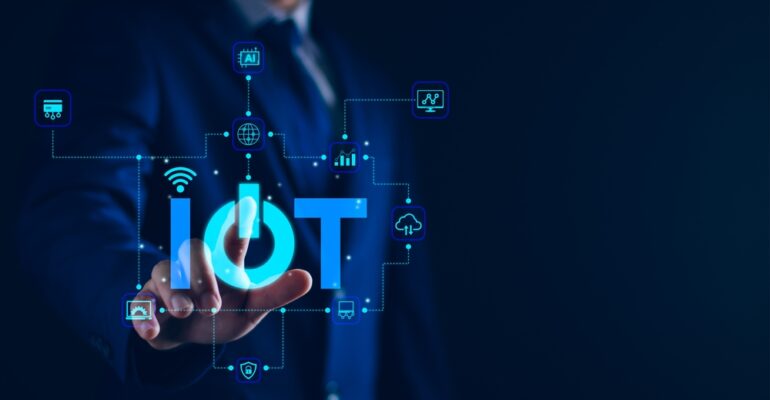Internet of Things (IoT): Transforming the World Through Connectivity

Internet of Things (IoT): Transforming the World Through Connectivity
The Internet of Things (IoT) is revolutionizing the way we live, work, and interact with the world around us. By enabling devices to communicate and share data, IoT creates smarter, more efficient systems that drive innovation across various industries. From healthcare to manufacturing, IoT’s impact is profound and far-reaching. This blog explores the fundamentals of IoT, its applications, importance, enabling technologies, challenges, and its promising future.
How Does IoT Work?
At its core, IoT is a network of physical objects or “things” embedded with sensors, software, and other technologies to connect and exchange data over the internet. These “things” can range from household appliances to industrial machines and wearables.
IoT works through the following process:
- Data Collection: Sensors in IoT devices gather real-time data.
- Connectivity: Devices connect to the internet or other networks using technologies like Wi-Fi, Bluetooth, or cellular networks.
- Data Processing: Cloud-based or edge computing systems process and analyze the data.
- Action: Insights are generated to enable automated or user-driven actions.
Example IoT Applications
IoT is transforming multiple industries by enhancing efficiency, decision-making, and user experiences.
1. Retail
- Applications: Smart shelves, automated checkout systems, and personalized promotions.
- Benefits: Improved inventory management, reduced theft, and enhanced customer experience.
2. Healthcare
- Applications: Remote patient monitoring, wearable health devices, and smart hospital systems.
- Benefits: Early diagnosis, better patient outcomes, and reduced healthcare costs.
3. Agriculture
- Applications: Smart irrigation systems, precision farming, and livestock monitoring.
- Benefits: Increased crop yield, reduced resource wastage, and sustainable farming.
4. Manufacturing
- Applications: Predictive maintenance, smart factories, and real-time supply chain management.
- Benefits: Reduced downtime, optimized processes, and cost savings.
5. Transportation
- Applications: Autonomous vehicles, fleet management, and smart traffic systems.
- Benefits: Reduced accidents, lower fuel consumption, and improved logistics.
Why Are IoT Solutions Important?
IoT solutions drive efficiency, innovation, and sustainability:
- Enhanced Decision-Making: IoT provides actionable insights through real-time data.
- Cost Efficiency: Automation reduces labor and operational costs.
- Better Customer Experiences: Personalized services foster loyalty and satisfaction.
- Sustainability: IoT enables resource optimization and environmental conservation.
The Technologies That Make IoT Possible
Several cutting-edge technologies power IoT ecosystems:
- Sensors and Actuators: Gather and execute data-driven instructions.
- Wireless Communication Protocols: Wi-Fi, Bluetooth, Zigbee, and LoRa ensure seamless connectivity.
- Cloud Computing: Stores and processes massive IoT data sets.
- Edge Computing: Enables faster data processing near the source.
- Artificial Intelligence (AI): Analyzes data to provide predictive and prescriptive insights.
- 5G Technology: Offers faster and more reliable connectivity for IoT devices.
Risks and Challenges in IoT
While IoT offers immense potential, it comes with challenges:
- Security and Privacy: IoT devices are vulnerable to cyberattacks, posing risks to sensitive data.
- Interoperability: Different devices and platforms often lack standardization, hindering integration.
- Scalability: Managing large IoT ecosystems can be complex.
- Cost: Initial setup and maintenance of IoT systems can be expensive.
- Regulatory Compliance: Adhering to data privacy laws is critical but challenging.
How Should Businesses Approach IoT?
To successfully implement IoT, businesses should:
- Define Clear Goals: Understand what they aim to achieve with IoT.
- Start Small: Pilot IoT projects to assess feasibility and ROI.
- Ensure Security: Invest in robust cybersecurity measures.
- Collaborate with Experts: Partner with NAKA for technical expertise.
- NAKA offers end-to-end IoT solutions, helping businesses design, deploy, and manage IoT ecosystems tailored to their unique needs. With a strong focus on innovation and reliability, We ensure seamless integration of IoT technologies into existing workflows, enabling organizations to achieve their digital transformation goals efficiently.
- Adapt to Change: Continuously evaluate and update IoT systems to meet evolving needs.
The Future of IoT
IoT’s future is both exciting and transformative:
- AI Integration: Smarter systems with AI-driven automation and analytics.
- Increased Adoption: More industries will leverage IoT, from education to energy.
- Sustainable Solutions: IoT will play a critical role in addressing global challenges like climate change.
- Human-Centric Designs: Devices will focus on improving quality of life and accessibility.
- Global IoT Market Growth: The IoT market is expected to grow exponentially, driving innovation and economic impact.
The Internet of Things is not just a technological trend; it is a paradigm shift reshaping industries, economies, and societies. By leveraging IoT effectively, businesses and individuals can unlock unprecedented opportunities, paving the way for a smarter and more connected future.



